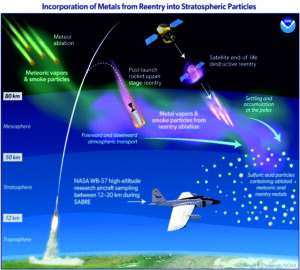Impacts of Ablating Space Debris in the Middle Atmosphere

Credit: Chelsea Thompson/NOAA
The rationale for this project comes from a recent study which involved flying a mass spectrometer in the lower stratosphere to sample the metallic elements contained in sulfuric acid droplets in the so-called Junge layer [Murphy et al., 2023]. It was discovered that around 10% of stratospheric droplets showed clear evidence of contamination from space debris, with some elements – Al, Li, Cu, Ni, Mn etc. – already significantly exceeding the natural input from the ablation of cosmic dust in the upper mesosphere and lower thermosphere. The effect of these metals in the stratosphere is currently unknown. Moreover, the amount of space debris entering the atmosphere is projected to increase by well over an order of magnitude in the next 15 years [Schulz and Glassmeier, 2021]. This growth will mainly arise from two factors: the projected increase in space-based assets, particularly mega-constellations of nano-satellites; and the agreed international requirement that their orbital lifetimes are limited to less than 5 years. It is therefore crucial to determine the level of re-entering space debris which will cause significant changes to the atmospheric chemistry of the stratosphere, particularly to the ozone layer.
The purpose of this project will be to quantify – for the first time – impacts on the chemistry and dynamics of the middle atmosphere (in particular, the stratospheric ozone layer) and on climate, caused by the injection of aluminium-containing particles produced from space debris ablating above 40 km. These impacts may include the surface-catalyzed photolysis of hydrogen chloride (the major chlorine reservoir), and increased freezing of polar stratospheric clouds; both of which would enhance ozone destruction, changing the radiative balance of the atmosphere and increasing harmful UV light at the surface. Changes in the circulation of the middle atmosphere e.g. the winter polar vortices, may also affect ozone. The particles may also exert a significant negative radiative forcing, leading to a cooling of the lower atmosphere. The ultimate objective will be to determine an upper limit to the satellite mass which should be in near-Earth orbit, in order to avoid adverse environmental impacts.
The project will primarily use the Community Aerosol and Radiation Model for Atmospheres (CARMA) model implemented within the Whole Atmosphere Community Climate Model (WACCM), developed at the National Center for Atmospheric Research in the US. We have previously used this model for our study of the transport of meteoric smoke particles in the atmosphere and their surface deposition [Brooke et al., 2017]. WACCM-CARMA will be used to simulate the injection of aluminium-containing particles from space debris, and the subsequent transport and interactions of these particles with sulfuric acid and meteoric smoke particles in the stratosphere; and hence model the potentially important impacts of these particles on chemistry and related atmospheric dynamics and climate.
The student would have an opportunity to engage in some experimental work: with Dr Juan Carlos Gómez Martín (Instituto Astrofísica Andalucía in Granada, Spain), who is studying the ablation of space debris materials; with Dr Sandy James (School of Chemistry, Leeds), who is working on the heterogeneous chemistry of particles produced by ablation; and with Dr Michael Gerding (Institute for Atmospheric Physics, Kühlungsborn, Germany), who is carrying out lidar observations of metals produced by the ablation of space debris in the upper mesosphere. There may also be the opportunity to spend time at the National Center for Atmospheric Research in Boulder, US, working with Dr Simone Tilmes on future developments of the WACCM-CARMA model.
Brooke, J. S. A., W. Feng, J. D. Carrillo-Sánchez, G. W. Mann, A. D. James, C. G. Bardeen, and J. M. C. Plane ( 2017), Meteoric Smoke Deposition in the Polar Regions: A Comparison of Measurements With Global Atmospheric Models, J. Geophys. Res.–Atmos. , 122, 11,112–111,130, doi: 10.1002/2017JD027143.
Murphy, D. M., et al. ( 2023), Metals from spacecraft reentry in stratospheric aerosol particles, Proc. Nat. Acad. Sci., 120, art. no. e2313374120, doi: 10.1073/pnas.2313374120.
Schulz, L., and K.-H. Glassmeier (2021), On the anthropogenic and natural injection of matter into Earth’s atmosphere, Adv. Space Res., 67, 1002–1025.
